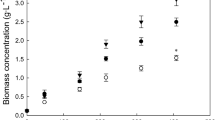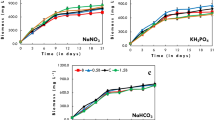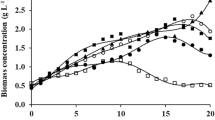Abstract
Current interest in the production of commercial biopolymers which are derived from renewable resources arises from the necessity to move from a fossil-based to a more sustainable economy. Microalgae are considered potential biopolymer producers although their use at an industrial scale is not feasible yet. In this sense, medium optimisation and operational conditions can be considered the first steps leading to growth and product productivity enhancement which are a prerequisite to boost the microalgae industry. This manuscript describes medium optimisation for two promising strains of the green alga Botryococcus braunii, B. braunii CCALA-778 (race A) and B. braunii AC761 (race B), which are natural producers of (exo)polysaccharides and hydrocarbons of high interest in the biopolymers industry. Medium optimisation was based on a three-step research process: (i) a literature survey to identify macro- and micronutrients that could be limiting Botryococcus growth, (ii) a 3-level factorial design experiment in microwell plates to evaluate modified media accordingly and (iii) validation of previous results in batch cultivation in Roux flasks. The results obtained show the significant impact of culture media optimisation in the growth dynamics and valuable compound accumulation of B. braunii. Attention should be given to each particular Botryococcus race and media should be defined accordingly. But overall, the new optimised media resulted in higher productivities which may contribute to reach sustainability of Botryococcus cultivation.





Similar content being viewed by others
References
Allard B, Casadevall E (1990) Carbohydrate composition and characterization of sugars from the green microalga Botryococcus braunii. Phytochemistry 29:1875–1878
Ambati RR, Ravi S, Aswathanarayana RG (2010) Enhancement of carotenoids in green alga-Botryococcus braunii in various autotrophic media under stress conditions. Int J Biomed Pharmaceut Sci 4:87–92
Arad S, Rapoport L, Moshkovich A, van Moppes D, Karpasas M, Golan R, Golan Y (2006) Superior biolubricant from a species of red microalga. Langmuir 22:7313–7317
Araie H, Shiraiwa Y (2009) Selenium utilization strategy by microalgae. Molecules 14:4880–4891
Banerjee A, Sharma R, Chisti Y, Banerjee UC (2002) Botryococcus braunii: a renewable source of hydrocarbons and other chemicals. Crit Rev Biotechnol 22:245–279
Becker EW (1994) Microalgae: biotechnology and microbiology. Cambridge University Press, Cambridge, UK, 293 p
Bischoff HW, Bold HC (1963) Phycological studies IV. Some soil algae from enchanted rock and related algal species. Phycological Studies, University of Texas 4:1–95
Blifernez-Klassen O, Chaudhari S, Klassen V, Wördenweber R, Steffens T, Cholewa D, Niehaus K, Kalinowski J, Kruse O (2018) Metabolic survey of Botryococcus braunii: impact of the physiological state on product formation. PLoS One 13:e0198976
Bligh EG, Dyer WJ (1959) A rapid method of total lipid extraction and purification. Can J Biochem Physiol 37:911–917
Brown KM, Arthur JR (2001) Selenium, selenoproteins and human health: a review. Public Health Nutr 4:593–599
Casadevall E, Dif D, Largeau C, Gudin C, Chaumont D, Desanti O (1985) Studies on batch and continuous cultures of Botryococcus braunii: hydrocarbon production in relation to physiological state, cell ultrastructure and phosphate nutrition. Biotechnol Bioeng 27:286–295
Cheng PF, Ji B, Gao L, Zhang W, Wang J, Liu T (2013) The growth, lipid and hydrocarbon production of Botryococcus braunii with attached cultivation. Bioresour Technol 138:95–100
Choi HJ, Lee SM (2015) Effect of the N/P ratio on biomass productivity and nutrient removal from municipal wastewater. Bioprocess Biosyst Eng 38:761–766
Correll DL (1998) The role of phosphorus in the eutrophication of receiving waters: a review. J Environ Qual 27:261–266
Cosgrove J, Borowitzka MA (2011) Chlorophyll fluorescence terminology: an introduction. In: Suggett DJ, Prášil O, Borowitzka MA (eds) Chlorophyll a fluorescence in aquatic sciences. Springer, Dordrecht, pp 1–17
Cuaresma M, Janssen M, Vílchez C, Wijffels RH (2009) Productivity of Chlorella sorokiniana in a short light-path (SLP) panel photobioreactor under high irradiance. Biotechnol Bioeng 104:352–359
Cuaresma M, Buffing MF, Janssen M, Vílchez C, Wijffels RH (2012) Performance of Chlorella sorokiniana under simulated extreme winter conditions. J Appl Phycol 24:693–699
Dayananda C, Sarada R, Bhattacharya S, Ravishankar GA (2005) Effect of media and culture conditions on growth and hydrocarbon production by Botryococcus braunii. Process Biochem 40:3125–3131
Dayananda C, Sarada R, Kumar V, Ravishankar GA (2007) Isolation and characterization of hydrocarbon producing green alga Botryococcus braunii from Indian fresh water bodies. Microb Biotechnol 10
Díaz KC, Atehortúa L (2014) Effect of different media on exopolysaccharide and biomass production by the green microalgae Botryococcus braunii. J Appl Phycol 26:2087–2095
Dubois M, Gilles KA, Hamilton JK, Rebers PA, Smith F (1956) Colorimetric method for determination of sugars and related substances. Anal Chem 28:350–356
Fernandes HL, Lupi F, Tomé MM, Sá-Correia I, Novais JM (1991) Rheological behaviour of the culture medium during growth of the microalga Botryococcus braunii. Bioresour Technol 38:133–136
Folch J, Lees M, Sloane-Stanley GH (1957) A simple method for the isolation and purification of total lipides from animal tissues. J Biol Chem 226:497–509
Furuhashi K, Saga K, Okada S, Imou K (2013) Seawater-cultured Botryococcus braunii for efficient hydrocarbon extraction. PLoS One 8:e66483
Ge Y, Liu J, Tian G (2011) Growth characteristics of Botryococcus braunii 765 under high CO2 concentration in photobioreactor. Bioresour Technol 102:130–134
Geider RJ, La Roche J (1994) The role of iron in phytoplankton photosynthesis, and the potential for iron-limitation of primary productivity in the sea. Photosynth Res 39:275–301
Gojkovic Z, Vílchez C, Torronteras R, Vigara J, Gómez-Jacinto V, Janzer N, Gómez Ariza JL, Márová I, Garbayo I (2014) Effect of selenate on viability and selenomethionine accumulation of Chlorella sorokiniana grown in batch culture. Sci World J 2014:401265
Gojkovic Z, Garbayo I, Gómez Ariza JL, Márová I, Vílchez C (2015) Selenium bioaccumulation and toxicity in cultures of green microalgae. Algal Res 7:106–116
Gouveia JD, Ruiz J, Van den Broek LAM, Hesselink T, Peters S, Kleinegris DMM, Smith AG, Van der Veen D, Barbosa MJ, Wijffels RH (2017) Botryococcus braunii strains compared for biomass productivity, hydrocarbon and carbohydrate content. J Biotechnol 258:77–86
Guillard RRL (1975) Culture of phytoplankton for feeding marine invertebrates. In: Smith WL, Chanley MH (eds) Culture of marine invertebrate animals. Plenum Press, New York, pp 26–60
Hopkins WG, Hüner NPA (2009) Introduction to plant physiology, 4th edn. John Wiley & Sons, New Jersey
Hutchins DA, Bruland KW (1998) Iron-limited diatom growth and Si:N uptake ratios in a coastal upwelling regime. Nature 393:561–564
Kawachi M, Tanoi T, Demura M, Kaya K, Watanabe MM (2012) Relationship between hydrocarbons and molecular phylogeny of Botryococcus braunii. Algal Res 1:114–119
Kita K, Okada S, Sekino H, Imou K, Yokoyama S, Amano T (2010) Thermal pre-treatment of wet microalgae harvest for efficient hydrocarbon recovery. Appl Energy 87:2420–2423
Kojima E, Zhang K (1999) Growth and hydrocarbon production of microalga Botryococcus braunii in bubble column photobioreactors. J Biosci Bioeng 87:811–815
Kouba A, Velíšek J, Stará A, Masojídek J, Kozák P (2014) Supplementation with sodium selenite and selenium-enriched microalgae biomass show varying effects on blood enzymes activities, antioxidant response, and accumulation in common Barbel (Barbus barbus). BioMed Res Int 2914:408270
Lagus A, Suomela J, Weithoff G, Heikkilä K, Helminen H, Sipura J (2004) Species-specific differences in phytoplankton responses to N and P enrichments and the N: P ratio in the Archipelago Sea, northern Baltic Sea. J Plankton Res 26:779–798
Largeau C, Casadevall E, Berkaloff C, Dhamelincourt P (1980) Sites of accumulation and composition of hydrocarbons in Botryococcus braunii. Phytochemistry 19:1043–1051
Lee SJ, Yoon BD, Oh HM (1998) Rapid method for the determination of lipid from the green alga Botryococcus brauii. Biotech Techniques 12:553–556
Li Y, Qin JG (2005) Comparison of grow than lipid content in three Botryococcus braunii strains. J Appl Phycol 17:551–556
Liu L, Wang Y, Zhang Y, Chen X, Zhang P, Ma S (2013) Development of a new method for genetic transformation of the green alga Chlorella ellipsoidea. Mol Biotechnol 54:211–219
Llamas A, Tejada-Jiménez M, Fernández E, Galván A (2011) Molybdenum metabolism in the alga Chlamydomonas stands at the crossroad of those in Arabidopsis and humans. Metallomics 3:578–590
Lupi FM, Fernandes FLM, Tomé MM, Sá-Correia I, Novais JM (1994) Influence of nitrogen source and photoperiod on exopolysaccharide synthesis by the microalga Botryococcus braunii UC 58. Enz Microb Technol 16:546–550
Markou G, Chatzipavlidis I, Georgakakis D (2012) Carbohydrates production and bio-flocculation characteristics in cultures of Arthrospira (Spirulina) platensis: improvements through phosphorus limitation process. Bioenergy Res 5:915–925
Maxwell K, Johnson GN (2000) Chlorophyll fluorescence-a practical guide. J Exp Bot 51:659–668
Metzger P, Largeau C (2005) Botryococcus braunii: a rich source for hydrocarbons and related ether lipids. Appl Microbiol Biotechnol 66:486–496
Mills MM, Arrigo KR (2010) Magnitude of oceanic nitrogen fixation influenced by the nutrient uptake ratio of phytoplankton. Nat Geosci 3:412–416
Moheimani NR, Matsuura H, Watanabe MM, Borowitzka MA (2014) Non-destructive hydrocarbon extraction from Botryococcus braunii BOT-22 (race B). J Appl Phycol 26:1453–1464
Nieuwerburgh LV, Wänstrand I, Snoeijs P (2004) Growth and C:N:P ratios in copepods grazing on N- or Si-limited phytoplankton blooms. Hydrobiologia 514:57–72
Qin J (2005) Bio-hydrocarbons from algae: impacts of temperature, light and salinity on algae growth. Rural Industries Research and Development Corporation Report 26. RIRDC, Canberra
Rao AR, Dayananda C, Sarada R, Shamala TR, Ravishankar GA (2007) Effect of salinity on growth of green alga Botryococcus braunii and its constituents. Bioresour Technol 98(3:560–564
Rao RR, Jiao A, Kohn DH, Stegemann JP (2012) Exogenous mineralization of cell-seeded and unseeded collagen–chitosan hydrogels using modified culture medium. Acta Biomater 8:1560–1565
Raven JA (1988) The iron and molybdenum use efficiencies of plant growth with different energy, carbon, and nitrogen sources. New Phytol 109:279–287
Redfield AC (1934) On the proportions of organic derivations in sea water and their relation to the composition of plankton. In: Daniel RJ (ed) James Johnstone memorial volume. University Press of Liverpool, Liverpool, pp 176–192
Ruangsomboon S (2012) Effect of light, nutrient, cultivation time and salinity on lipid production of newly isolated strain of the green microalga, Botryococcus braunii KMITL 2. Bioresour Technol 109:261–265
Ruiz-Domínguez MC, Vaquero I, Obregón V, De la Morena B, Vílchez C, Vega JM (2014) Lipid accumulation and antioxidant activity in the eukaryotic acidophilic microalga Coccomyxa sp. (strain onubensis) under nutrient starvation. J Appl Phycol 27:1099–1108
Sakamoto K, Baba M, Suzuki I, Watanabe MM, Shiraiwa Y (2012) Optimization of light for growth, photosynthesis, and hydrocarbon production by the colonial microalga Botryococcus braunii BOT-22. Bioresour Technol 110:474–479
Shimamura R, Watanabe S, Sakakura Y, Shiho M, Kaya K, Watanabe MM (2012) Development of Botryococcus seed culture system for future mass culture. Procedia Environ Sci 15:80–89
Smith VH (1979) Nutrient dependence of primary productivity in lakes. Limnol Oceanogr 24:1051–1064
Song L, Qin JG, Su S, Xu J, Clarke S, Shan Y (2012) Micronutrient requirements for growth and hydrocarbon production in the oil producing green alga Botryococcus braunii (Chlorophyta). PLoS One 7:e41459
Stanier RY, Kunisawa R, Mandel M, Cohen-Bazire G (1971) Purification and properties of unicellular blue-green algae (Order Chroococcales). Bacteriol Rev 35:171–205
Suastes-Rivas JK, Hernández-Altamirano R, Mena-Cervantes VY, Chairez I (2020) Simultaneous optimization of biomass and metabolite production by a microalgae yeast co-culture under inorganic micronutrients. BioEnergy Res 13:974–985
Sueoka N, Chiang KS, Kates JR (1967) Deoxyribonucleic acid replication in meiosis of Chlamydomonas reinhardtii: I. Isotopic transfer experiments with a strain producing eight zoospores. J Molec Biol 25:47–66
Talero E, García-Mauriño S, Ávila-Román J, Rodríguez-Luna A, Alcaide A, Motilva V (2015) Bioactive compounds isolated from microalgae in chronic inflammation and cancer. Mar Drugs 13:6152–6209
Tanoi T, Kawachi M, Watanabe MM (2011) Effects of carbon source on growth and morphology of Botryococcus braunii. J Appl Phycol 23:25–33
Tanoi T, Kawachi M, Watanabe MM (2014) Iron and glucose effects on the morphology of Botryococcus braunii with assumption on the colony formation variability. J Appl Phycol 26:1–8
Tejada-Jiménez M, Galván A, Fernández E (2011) Algae and humans share a molybdate transporter. Proc Nat Acad Sci 108:6420–6425
Weiss TL, Roth R, Goodson C, Vitha S, Black I, Azadi P, Rusch J, Holzenburg A, Timothy P, Devarenne TP, Goodenough U (2012) Colony organization in the green alga Botryococcus braunii (race B) is specified by a complex extracellular matrix. Eukaryot Cell 11:1424–1440
Yang S, Wang J, Cong W, Cai Z, Ouyang F (2004) Utilization of nitrite as a nitrogen source by Botryococcus braunii. Biotechnol Lett 26:239–243
Yeesang C, Cheirsilp B (2011) Effect of nitrogen, salt, and iron content in the growth medium and light intensity on lipid production by microalgae isolated from freshwater sources in Thailand. Bioresour Technol 102:3034–3040
Yingying S, Hui W, Ganlin G, Yinfan P, Binlun Y (2014) The isolation and antioxidant activity of polysaccharides from the marine microalgae Isochrysis galbana. Carbohydr Polym 113:22–31
Yoshida M, Tanabe Y, Yonezawa N, Watanabe MM (2012) Energy innovation potential of oleaginous microalgae. Biofuels 3:761–781
Yoshimura T, Okada S, Honda M (2013) Culture of the hydrocarbon producing microalga Botryococcus braunii strain Showa: optimal CO2, salinity, temperature, and irradiance conditions. Bioresour Technol 133:232–239
Zhang J, Liu L, Ren Y, Chen F (2019) Characterization of exopolysaccharides produced by microalgae with antitumor activity on human colon cancer cells. Int J Biol Macromol 128:761–767
Funding
This work has been supported financially by the European Union under the Seventh framework programme (Project SPLASH: http://www.eu-splash.eu; contract number 311956).
Author information
Authors and Affiliations
Corresponding author
Ethics declarations
Conflict of interest
The authors declare that they have no conflict of interest.
Additional information
Publisher’s note
Springer Nature remains neutral with regard to jurisdictional claims in published maps and institutional affiliations.
This research work was carried out while Elisabeth Bermejo was working at Algal Biotechnology Group, University of Huelva, CIDERTA.
Rights and permissions
About this article
Cite this article
Bermejo, E., Muñoz, Á., Ramos-Merchante, A. et al. Medium optimisation as a first step towards the feasible production of biopolymers with Botryococcus braunii. J Appl Phycol 32, 3667–3678 (2020). https://doi.org/10.1007/s10811-020-02245-7
Received:
Revised:
Accepted:
Published:
Issue Date:
DOI: https://doi.org/10.1007/s10811-020-02245-7




